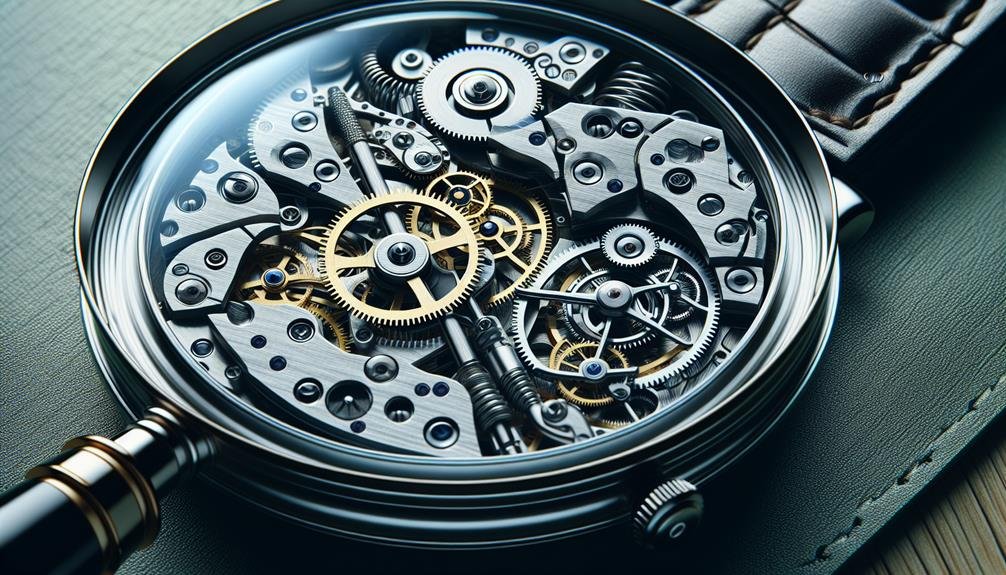Mechanical watch movements are marvels of precision and craftsmanship. Imagine an orchestra of gears, springs, and wheels working in perfect harmony – that's your watch. The mainspring, akin to a coiled energy reservoir, drives the hands. This power is then distributed efficiently through a series of gears and wheels. This isn't just function, but art in motion. There's more to these watches than meets the eye: waterproofing techniques, careful lubrication, and regular servicing all play crucial roles. There's a whole world of intricate details awaiting you, just beneath the watch face. Interested? Let's unravel these complexities, one tick at a time.
The Art of Watchmaking

While it may appear complex, understanding the art of watchmaking can illuminate the intricate precision and craftsmanship that goes into every mechanical watch movement. It's not just about the function, but also the form. Watch aesthetics play a significant role in this art form, combining both beauty and functionality.
The craftsmanship evolution in the watchmaking industry is a testament to the relentless pursuit of perfection. Beginning with simple sundials, now you're gazing at the intricate mechanical watches that are a marvel of human ingenuity. It's a journey that has spanned centuries, each era bringing in new techniques and designs, enhancing not just the mechanics but also the aesthetics of watches.
From the layout of the watch face to the choice of materials, every detail matters. The watch hands, the dial, the case, the strap – they're all carefully chosen and crafted to create a harmonious ensemble. You're not just wearing a timepiece; you're wearing a piece of art.
Understanding Mechanical Watches
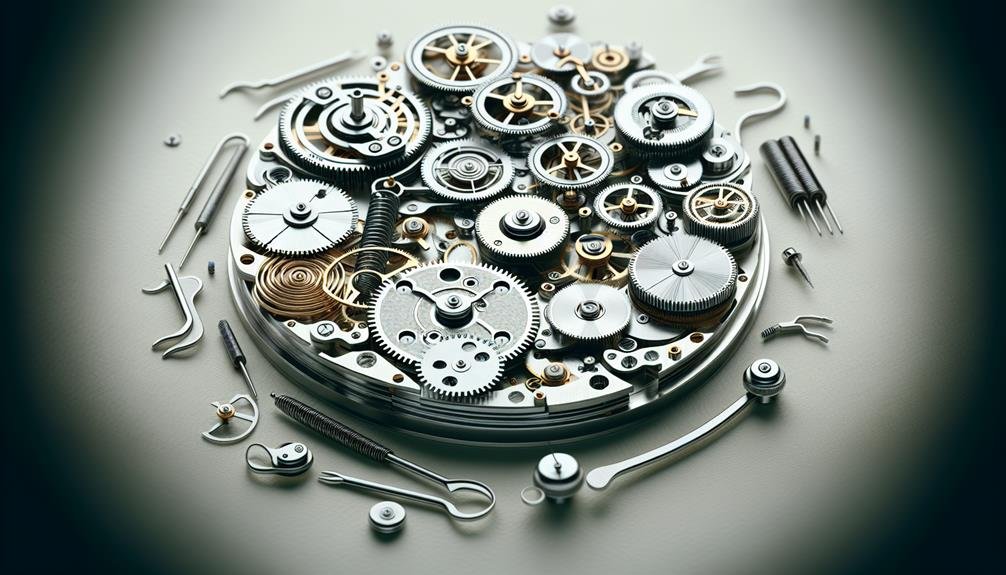
Diving into the mechanics of a watch, you'll often find yourself in awe of the intricate system of gears and springs that keep time so accurately. It's an engineering marvel that blends watch aesthetics with mechanical durability.
Understanding mechanical watches requires appreciating their resilience first. Every tick and tock, every second hand movement, results from the ceaseless action of tiny components working harmoniously. This mechanical durability, an attribute of the watch's inner workings, is a testament to the watchmaker's skill and precision. It's not just about telling time; it's about doing so, year after year, with unerring accuracy.
But it's not all about the mechanics. The watch aesthetics play an equally important role. The design, the choice of materials, the finish- all contribute to a watch's visual appeal. A well-designed watch can be a statement of style, a reflection of personality. When you wear a mechanical watch, you're not just wearing a timepiece. You're wearing a piece of art, a marvel of engineering, a testament to human ingenuity.
Anatomy of a Watch Movement
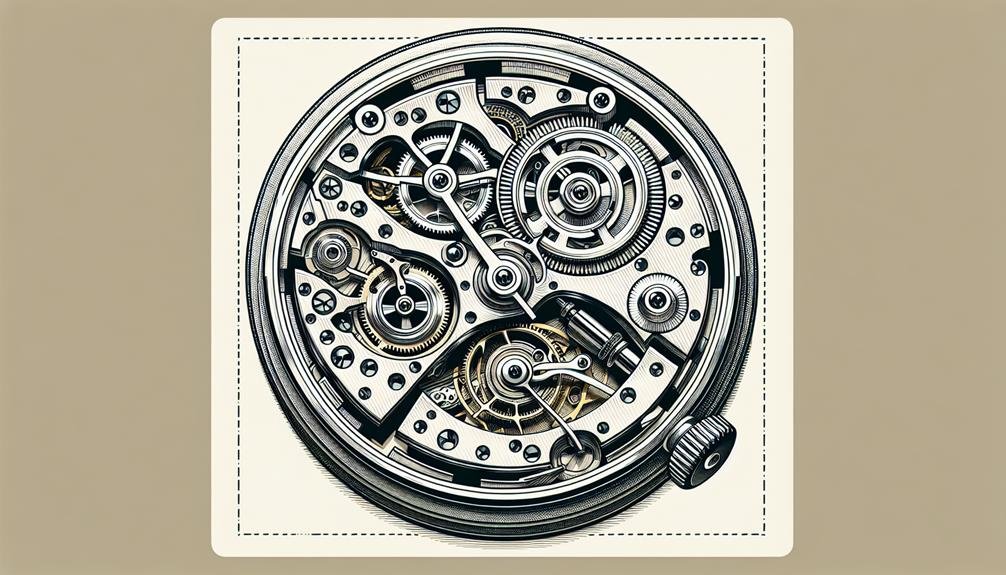
Let's peel back the layers of a mechanical watch to uncover the intricate dance of gears and springs that make up its movement. It's a beautiful ballet, where each piece has a role to play in the overall performance. This is your movement assembly, the heart and soul of your timepiece.
Imagine the movement assembly as an orchestra, each part working in harmony to create the symphony of time. Your power reserve, akin to the conductor, ensures the performance continues flawlessly. It's your timepiece's stamina, dictating how long your watch can perform without winding. It's a crucial part of the anatomy, like a heart driving blood through a body.
The escapement, balance wheel, and hairspring are key performers in this orchestra, each contributing to the accurate flow of time. They're intricate, delicate, and crafted with an almost unimaginable precision. But let's not forget the winding mechanism and gear train, vital components that keep the whole show running smoothly.
The anatomy of a watch movement is a marvel of mechanical engineering. It's a testament to the skill, patience, and meticulousness of watchmakers who create these miniature worlds of gears and springs, all encased within the confines of a watch.
The Mainspring: Powerhouse of Time
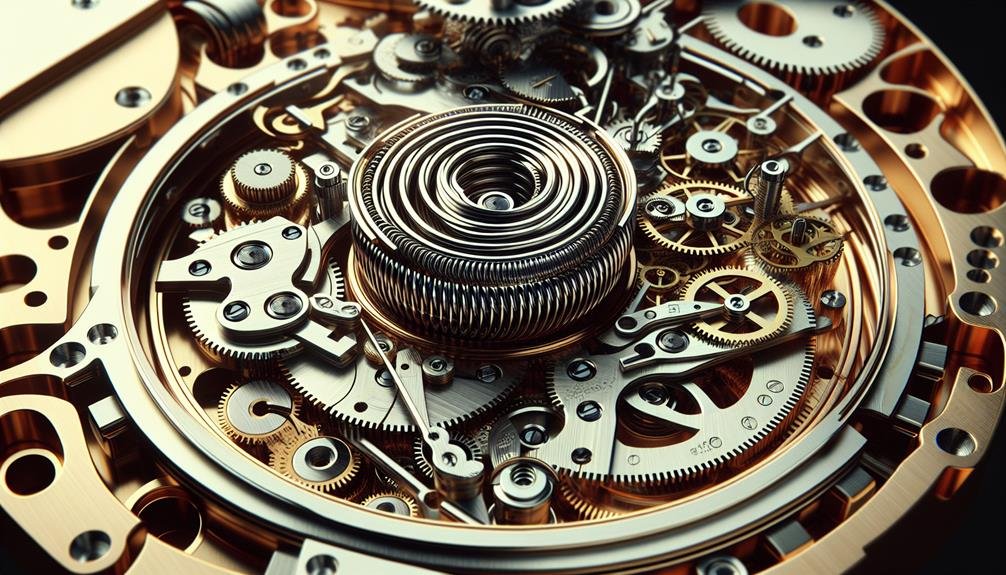
At the heart of your mechanical watch's movement lies the mainspring, the true powerhouse that drives the hands of time. This small, coiled spring is responsible for storing the energy that keeps your watch ticking.
Now, you might be wondering how this power is harnessed. It's all about spring coiling techniques. The mainspring is wound either manually, by turning the crown on your watch, or automatically, through the motion of your wrist. When it's fully wound, the spring's stored energy is at its peak, ready to power your watch for days.
Mainspring material selection is also crucial. In the early days, they were made of steel. But steel isn't the most durable material for a part that undergoes constant tension and release. So, watchmakers started using alloy materials, like Nivaflex or Elinvar. These alloys are more resistant to wear and tear, ensuring your mainspring, and by extension your watch, has a long life.
Gears and Wheels: Transmitting Energy
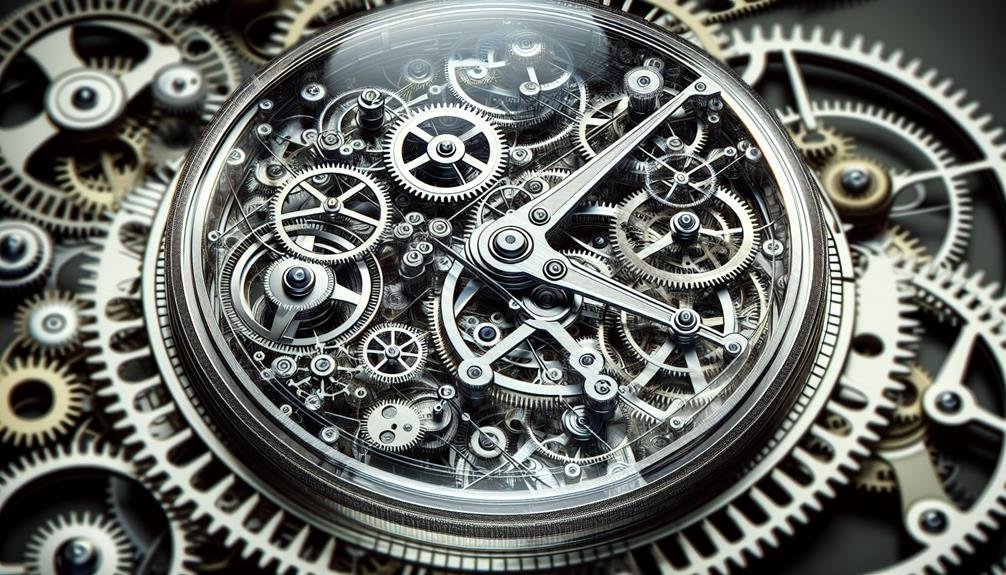
Once the mainspring has been wound, it's the gears and wheels in your watch that take center stage, transmitting the stored energy to power the timepiece. This transfer of power, or energy, is what keeps the hands of your watch moving in precise synchrony.
The gears and wheels work in harmony, ensuring energy efficiency. They're meticulously designed to optimize gear ratios, which means they need to balance speed with force. Think about it this way: too much force and the watch runs too quickly, too little and it won't run at all. The gear ratios are, therefore, crucial in maintaining the perfect balance.
The largest wheel, or gear, is called the center wheel. It's directly driven by the mainspring and turns once per hour. This wheel drives other smaller gears, each with a specific number of teeth to ensure accurate timekeeping. These wheels, in turn, drive the hands of your watch.
The gears and wheels aren't just functional; they also add to the aesthetic appeal of your watch. Watching them work together seamlessly, especially in a skeleton watch, is nothing short of mesmerizing. So next time you glance at your watch, remember the intricate dance of gears and wheels within, silently transmitting energy and marking time.
The Escapement: Regulating Time
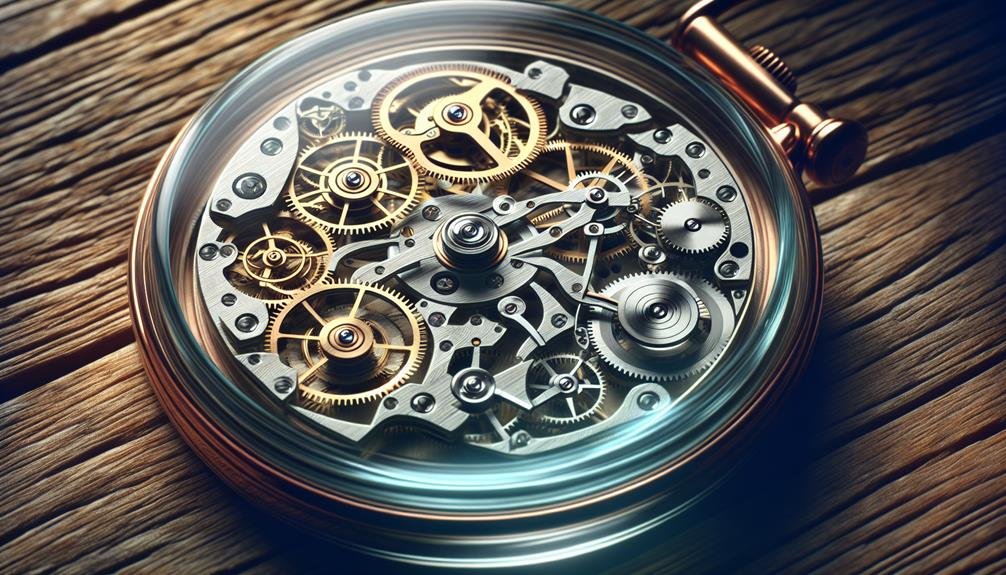
While the gears and wheels play a pivotal role in energy transmission, it's the escapement that regulates the rhythm of your watch. This mechanical marvel, often overlooked, holds the reins of time, ensuring your watch keeps pace with the world around you.
Delving into the escapement history, it's fascinating to see how the design has evolved over centuries. The earliest type, the verge escapement, was succeeded by the anchor escapement, which later paved the way for the modern Swiss lever escapement.
Each of these escapement types offers different levels of accuracy and durability. The Swiss lever escapement, for example, is renowned for its precision and reliability, making it the choice of many high-end watchmakers today. Conversely, the verge escapement, while outdated, holds historical significance as it was the first mechanism to bring portable timekeeping to the masses.
The Balance Wheel: Heartbeat of Precision

Just as the heart regulates the rhythm of your body, the balance wheel is the heartbeat of a mechanical watch, ensuring precision and accuracy in timekeeping. This vital component oscillates back and forth at a constant rate, typically between 5 and 10 times per second in modern watches.
The Balance Wheel's Evolution has been significant in watchmaking history. It was once made of steel, then brass, and now, synthetic materials like silicon are used. These advancements have enhanced the wheel's accuracy and the watch's overall performance.
Precision Enhancement Techniques have also played a big role in the wheel's improvement. Adjusting the balance wheel's weight distribution, for example, can significantly improve timekeeping accuracy. In addition, incorporating shock absorption systems can protect the balance wheel from impacts, ensuring it maintains its regular oscillations.
Complications: Beyond Telling Time

Diving deeper into the intricacies of mechanical watches, let's explore 'complications', those additional features that go beyond mere timekeeping. Complications are what make a watch more than just a timepiece. They're the bells and whistles that add functionality and increase the watch's value.
Now, you're probably wondering about complication evolution. Well, it's been a fascinating journey. It all started with basic features like displaying the date or day of the week. Over time, more complex features like moon phases and dual time zones were added. But it's the chronograph functionality that really impresses.
Imagine your watch as a stopwatch. That's what a chronograph does. It measures short periods of time, separate from the main time. You'll typically see two or three smaller dials for seconds, minutes, and sometimes hours. It's an incredibly handy feature, especially if you're into sports or other time-sensitive activities.
Care and Maintenance of Mechanical Watches
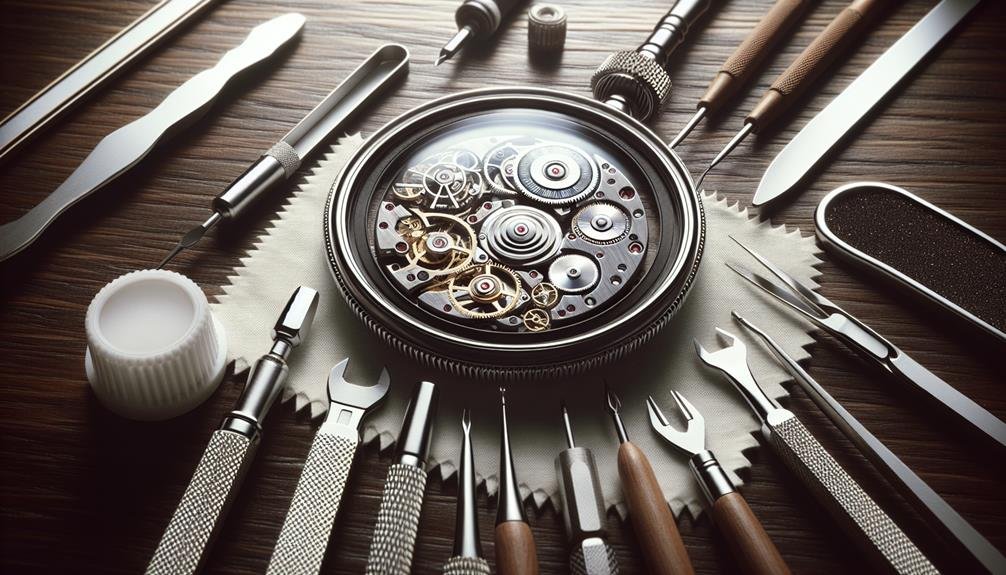
Ensuring your mechanical watch stays in pristine condition requires regular care and maintenance. You've got to understand the importance of the two key components: Waterproofing Techniques and Lubrication Essentials.
Waterproofing techniques are vital. You shouldn't assume your watch is water-resistant unless it's explicitly stated. It's best to avoid exposing it to water whenever possible. However, if your watch is water-resistant, ensure the gaskets are in top shape. They're responsible for sealing your watch and preventing water intrusion. Regular checks and replacements are a must.
Lubrication is equally important. The inner workings of your watch rely on it to function smoothly. Without proper lubrication, parts can wear down faster. You'll notice your watch might start losing or gaining time, a sign it's time for a service. Don't try to lubricate the watch yourself, leave it to professionals. They've the right tools and expertise.
Conclusion
So, you've journeyed through the captivating world of mechanical watches, unmasking their intricate mechanisms. From the powerhouse mainspring to the precision heartbeat of the balance wheel, it's clear these tiny marvels are more than mere timekeepers.
They're feats of engineering genius, requiring careful upkeep for their complications to shine. Remember, your watch is an artwork, treat it with the respect it deserves.
Here's to many timeless moments with your mechanical masterpiece!
